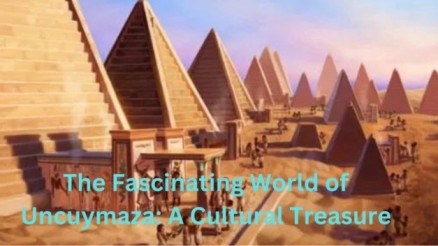When we think about traditional crafts, we often think of intricate designs and meaningful stories that have been passed down through generations. One such craft is Uncuymaza, an incredible tradition that has deep roots in the Andean cultures of South America. If you’re curious about its origins, significance, and modern relevance, let’s explore what makes it a cherished cultural treasure.
Introduction to Uncuymaza
What is Uncuymaza?
Uncuymaza is a traditional craft that holds a special place in the hearts of many South American communities, particularly in Peru, Bolivia, Ecuador, and northern Chile. It’s more than just art—it’s a vivid portrayal of history, spirituality, and cultural expression. People from these regions have used it as a way to tell their stories and maintain their identity over the centuries.
For the indigenous peoples of these areas, It isn’t just something pretty to look at; it’s an integral part of life. Whether it’s woven textiles or colorful designs, each piece holds deep meaning, showcasing the connection between people, nature, and the cosmos.
Historical Origins of Uncuymaza
Where Did Uncuymaza Begin?
The roots of Uncuymaza stretch back thousands of years to ancient Andean civilizations. Early on, this craft wasn’t just about decoration—it had practical uses in everyday life. For instance, the patterns woven into fabrics were used in ceremonies and agricultural practices, helping the communities stay connected to their spiritual beliefs and natural surroundings.
As time went on, the craft began to evolve, shifting from a purely functional tool into a deeply spiritual and cultural practice. By weaving intricate patterns, artisans were able to pass down ancient knowledge and uphold the traditions of their ancestors. These practices were essential for maintaining cultural continuity through changing times.
Cultural Significance of Uncuymaza
More Than Just Pretty Designs
When you look at a piece of Uncuymaza, it’s easy to be captivated by its vibrant colors and beautiful patterns. However, the designs are much more than just eye-catching—they carry symbolic meanings that are tied to nature, spirituality, and the people’s ancestral heritage.
Each color and shape has its own significance. For instance, earth tones might symbolize the connection to the land, while bold, bright colors could represent spiritual strength and resilience. The patterns are not randomly chosen; they tell stories of the natural world, community bonds, and even the divine forces believed to shape the universe.
A Symbol of Resilience
Uncuymaza has long been a symbol of resilience. Despite the challenges faced by these communities over centuries, from colonization to modern-day pressures, the craft has endured. It represents strength, perseverance, and a deep-rooted connection to the past, serving as a bridge that links generations.
Craftsmanship and Techniques
What Goes Into Making Uncuymaza?
The beauty of Uncuymaza comes from its craftsmanship, which is passed down through generations. Creating these pieces is a labor of love that involves skill, patience, and attention to detail.
Materials and Tools
Uncuymaza is traditionally made using natural materials, like wool and plant-based dyes. Artisans carefully select these materials from their environment to ensure the quality and vibrancy of the final product. The wool, often sourced from local animals, is spun and dyed with natural colors extracted from plants, giving each piece a distinct, earthy feel.
Traditional Weaving Methods
One of the most fascinating parts of it is the weaving process. Artisans use traditional techniques, passed down from their ancestors, to create intricate patterns and designs. These techniques require years of practice and a deep understanding of the craft. What’s even more special is that often communal families and villages come together to weave these pieces, creating a sense of unity and preserving the traditions of their ancestors.
Modern Relevance of Uncuymaza
Keeping Cultural Identity Alive
In today’s fast-paced world, many traditional practices face the threat of being forgotten. However, Uncuymaza continues to thrive and evolve, playing a key role in preserving cultural identity. For many Andean communities, this craft is a vital way to maintain a connection to their heritage. Wearing or displaying It is a reminder of where they come from and the rich history that shaped them.
Economic and Social Impact
Beyond its cultural significance, Uncuymaza also plays an important role in the local economy. As more people travel to South America to learn about indigenous cultures, It has gained attention and appreciation on a global scale. Tourists, art collectors, and enthusiasts contribute to the income of local artisans, creating opportunities for economic growth while ensuring that the craft is kept alive.
This resurgence of interest in indigenous crafts also fosters social cohesion within communities. By working together to create these beautiful pieces, artisans share knowledge, strengthen their bonds, and continue to pass down their cultural traditions.
Conclusion
A Legacy Worth Celebrating
Uncuymaza isn’t just a craft, it’s a vibrant expression of culture, history, and identity. From its ancient origins in the Andean highlands to its modern-day significance, this tradition continues to be a symbol of resilience and a link between generations. Whether you’re admiring a beautifully woven textile or learning about the artisans behind the craft, it’s clear that It is much more than just a beautiful piece of art it’s a living testament to the strength and spirit of indigenous communities.
You May Also Read: Jecizer Biosciences: Leading Innovation in Biotechnology
FAQs
- What is Uncuymaza?
Answer: Uncuymaza is a traditional craft deeply rooted in the Andean cultures of South America, particularly in Peru, Bolivia, Ecuador, and northern Chile. It’s an intricate art form that blends history, spirituality, and cultural expression, often through textiles and designs that represent the community’s connection to nature and ancestors.
- What are the historical origins of Uncuymaza?
Answer: Uncuymaza dates back to ancient Andean civilizations where it initially served practical purposes, such as in agricultural practices and ceremonial uses. Over time, it evolved into a significant cultural expression that reflects the beliefs, traditions, and environment of indigenous peoples in the Andean region.
- What does the design of Uncuymaza represent?
Answer: The designs in Uncuymaza are full of symbolism, representing elements of nature, spirituality, and ancestral heritage. Each pattern and color has a deep meaning, often conveying stories about the community’s connection to the land, the cosmos, and their spiritual beliefs.
- How is Uncuymaza crafted?
Answer: Uncuymaza is created using natural materials like wool and plant-based dyes. Artisans employ traditional weaving techniques, often working in a communal setting where families or entire villages come together to produce the intricate patterns that tell stories of identity, resilience, and cultural pride.
- Why is Uncuymaza important today?
Answer: Today, Uncuymaza remains a vital symbol of cultural identity and pride for Andean communities. It plays a key role in preserving traditions and fostering social cohesion. Additionally, it has gained global recognition, contributing to local economies through tourism and the appreciation of indigenous craftsmanship.



